Around 100 civilians were on Sunday evacuated from the Azovstal steelworks in Mariupol, the last holdout of Ukrainian forces in the city. Around 1,000 civilians and 2,000 Ukrainian fighters are thought to be sheltering in bunkers and tunnels underneath the plant, enduring a weeks-long siege with little food or water.
One of the civilians evacuated spoke to Reuters, telling the news agency, “We didn’t see the sun for so long”:
Cowering in the labyrinth of Soviet-era bunkers far beneath the vast Azovstal steel works, Natalia Usmanova felt her heart would stop she was so terrified as Russian bombs rained down on Mariupol, sprinkling her with concrete dust.
Usmanova, 37, spoke to Reuters on Sunday after being evacuated from the plant, a sprawling complex founded under Josef Stalin and designed with a subterranean network of bunkers and tunnels to withstand attack.
“I feared that the bunker would not withstand it – I had terrible fear,” Usmanova said, describing the time sheltering underground.
“When the bunker started to shake, I was hysterical, my husband can vouch for that: I was so worried the bunker would cave in.”
“We didn’t see the sun for so long,” she said, speaking in the village of Bezimenne in an area of Donetsk under the control of Russia-backed separatists around 30 km (20 miles) east of Mariupol.
She recalled the lack of oxygen in the shelters and the fear that had gripped the lives of people hunkered down there.
Usmanova was among dozens of civilians evacuated from the plant in Mariupol, a southern port city that has been besieged by Russian forces for weeks and left a wasteland.
Usmanova said she joked with her husband on the bus ride out, in a convoy agreed by the United Nations and the International Committee of the Red Cross (ICRC), that they would no longer have to go to the lavatory with a torch.
“You just can’t imagine what we have been through – the terror,” Usmanova said. “I lived there, worked there all my life, but what we saw there was just terrible.”
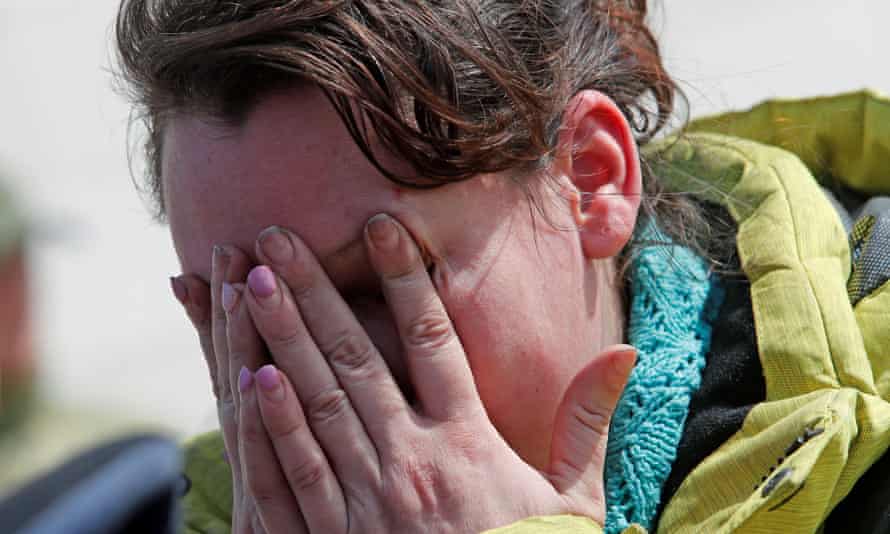
Thank you for following today’s coverage of the war in Ukraine.
We will be closing this liveblog but you can catch all the latest developments on our new blog launched below.
US first lady Jill Biden is set to visit Romania and Slovakia on Thursday for five days to meet with US service members and embassy personnel, displaced Ukrainian parents and children, humanitarian aid workers, and teachers, her office has said.
On Sunday, celebrated as Mother’s Day in the United States, Biden will meet with Ukrainian mothers and children who have been forced to flee their homes because of Russia’s war against Ukraine, her office said according to Reuters.
The wife of president Joe Biden will meet with US military service members at Mihail Kogalniceau Airbase in Romania on Friday, before heading to Bucharest to meet with Romanian government officials, US embassy staff, humanitarian aid workers, and teachers working with displaced Ukrainian children.
The trip also includes stops in the Slovakian cities of Bratislava, Kosice and Vysne Nemecke, where Biden will meet with government officials, refugees and aid workers, her office said.
Biden’s visit is the latest show of support for Ukraine and neighbouring countries that are helping Ukrainian refugees by top US representatives.
South Korean ambassador Kim Hyung-tae has returned to Kyiv along with some embassy staff, the news agency Yonhap has reported citing the Foreign Ministry in Seoul.
The South Korean embassy was evacuated at the beginning of the Russian invasion and staff had been working at a temporary office in the western Ukrainian city of Chernivtsi since March.
The ministry said Kim would start working from Kyiv on Monday and that it was considering the phased return of remaining staff in accordance with the future security situation there.
[They] plan to carry out tasks on diplomatic affairs and protecting [South Korean] nationals under closer cooperation with the Ukrainian government.
More than 20 embassies, including those of the EU, UK, France, Spain, Italy and the Netherlands, have already reopened in the Ukrainian capital.
US secretary of state Antony Blinken said US diplomats would gradually begin returning to the country during a visit to Kyiv last week.
Associated Press has filed a story saying that the Ghost of Kyiv, an unnamed fighter pilot who was praised for supposedly shooting down several Russian planes, is in fact a myth.
Ukrainian authorities admitted that the legendary pilot was a myth.
“The Ghost of Kyiv is a super-hero legend whose character was created by Ukrainians!” Ukraine’s air force said in Ukrainian on Facebook.
The statement came after multiple media outlets published stories wrongly identifying Major Stepan Tarabalka as the man behind the moniker. Tarabalka was a real pilot who died on March 13 during air combat and was posthumously awarded the title Hero of Ukraine, Ukraine’s air force said last month.
But he was not the Ghost of Kyiv, the force said in Saturday’s statement. “The information about the death of the The Ghost of #Kyiv is incorrect,” Ukraine’s air force wrote in a separate post Saturday on Twitter. “The #GhostOfKyiv is alive, it embodies the collective spirit of the highly qualified pilots of the Tactical Aviation Brigade who are successfully defending #Kyiv and the region.”
Adam Schiff, chairman of the US House Intelligence Committee, has told CNN “it’s only a matter of time” before US president Joe Biden visits Ukraine.
I have to think that a presidential visit is something under consideration, but only a question of how soon that will be feasible.
On Sunday US House speaker Nancy Pelosi became the highest ranking US official to meet Ukrainian president Volodymyr Zelenskiy in Kyiv since the start of Russia’s invasion at the end of February.
The House delegation had discussed Zelenskiy’s priorities for the next phase of the war, which is concentrated in the east of the country after Russian forces withdrew from around the capital, and Biden’s request for a $33bn aid package for Ukraine, Schiff said:
We wanted to discuss with him, within that really vast sum, what is the priority in terms of what weapons that he needs, what other assistance that he needs,” Schiff said. “We went through a detailed discussion of the next phase of the war. It’s moving from a phase in which Ukrainians were ambushing Russian tanks — it was close-quarters fighting — to fighting more at a distance using long range artillery, and that changes the nature of what Ukraine needs to defend itself.
Report: Russia’s top uniformed officer visited Ukraine last week
Russia’s top uniformed officer, General Valery Gerasimov, visited dangerous frontline positions in eastern Ukraine last week in a bid to reinvigorate the Russian offensive there, the New York Times has reported citing Ukrainian and US officials.
The Guardian was unable to verify the report.
During the visit, Gerasimov, chief of the Russian general staff, narrowly escaped a deadly Ukrainian attack on a school being used as a military base in the Russian-controlled city of Izium late Saturday, the Times reported.
Around 200 soldiers including at least one general were killed in the strike, a Ukrainian official told the paper, but Gerasimov had already departed for Russia.
The Institute for the Study of War, a US-based think tank, earlier said that Ukrainian forces had “likely conducted a rocket artillery strike on a Russian command post in Izyum on April 30 that struck after Russian chief of staff Valery Gerasimov had left but killed other senior Russian officers.”
US officials could not confirm the attack and the Russian Defence Ministry did not immediately respond to a request for comment.
“Our working assumption is that he was there because there’s a recognition they haven’t worked out all their problems yet,” one of the US officials told the Times. The Russian offensive has been slow, with widespread disarray and poor morale reported among Russian forces.
The Kremlin appears to be focusing its operations around the city of Izium as part of renewed efforts to seize the entirety of the Donetsk and Luhansk regions. Gerasimov has reportedly been put in command of the push.
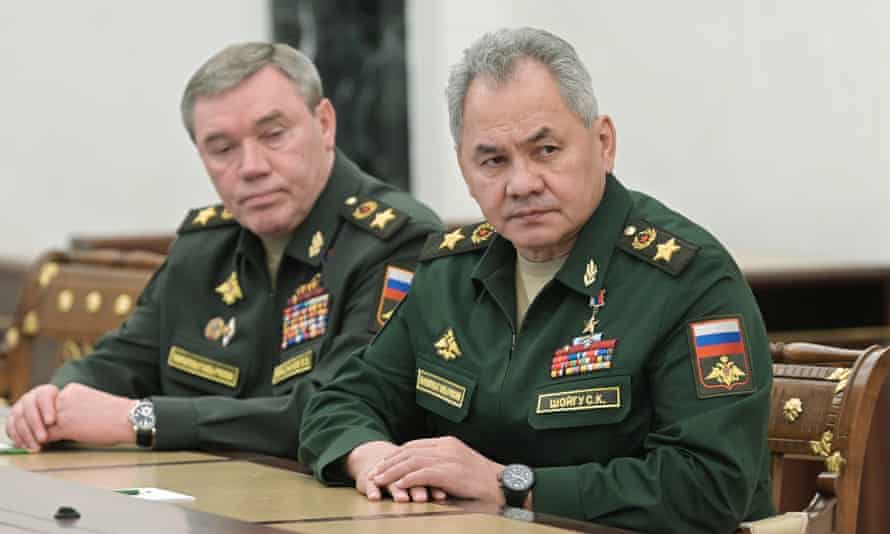
Explosions reported in Russian city of Belgorod
Two explosions have taken place in the early hours of Monday in Belgorod, the southern Russian region bordering Ukraine, Vyacheslav Gladkov, the region’s governor has written in a social media post.
“There were no casualties or damage,” Gladkov wrote, according to Reuters.
On Sunday Gladkov had said one person was injured in a fire at a Russian defence ministry facility in Belgorod, while seven homes had been damaged.
Posts on social media said fighter jets and loud explosions had been heard above the city overnight. The Guardian was unable to verify the reports.
Russia last month accused Ukraine of a helicopter attack on a fuel depot in Belgorod, for which Kyiv denied responsibility, as well as shelling villages and firing missiles at an ammunition depot.
A few more images captured by Reuters of the evacuation of civilians from the Azovstal steel works in Mariupol, showing emotional scenes as people were reunited with family members in the village of Bezimenne in the Donetsk region:
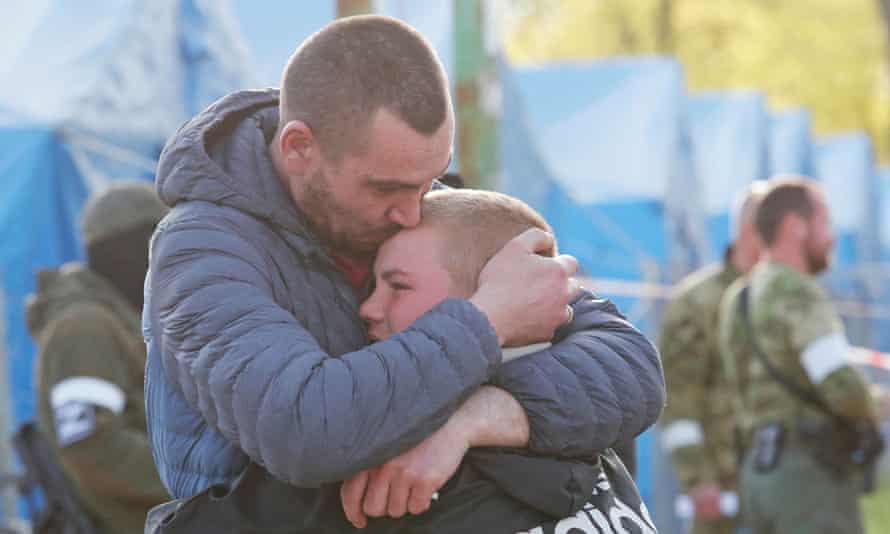
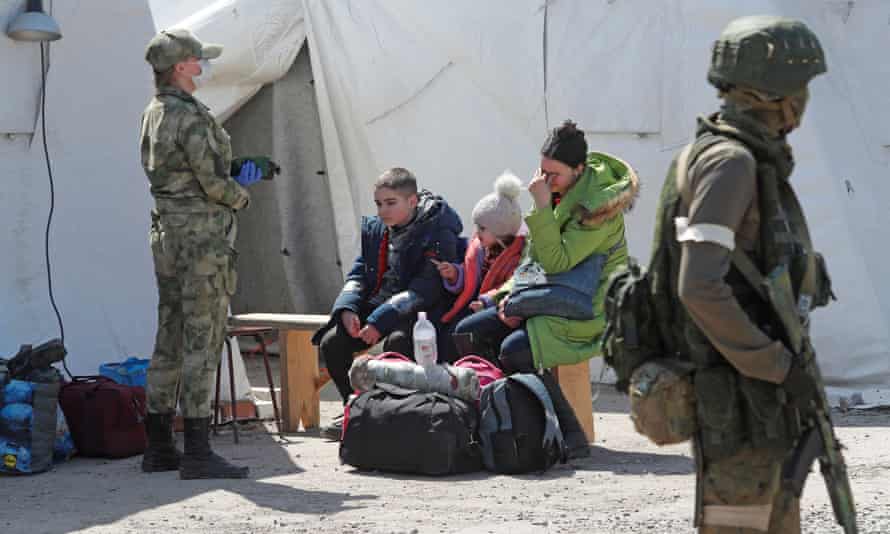
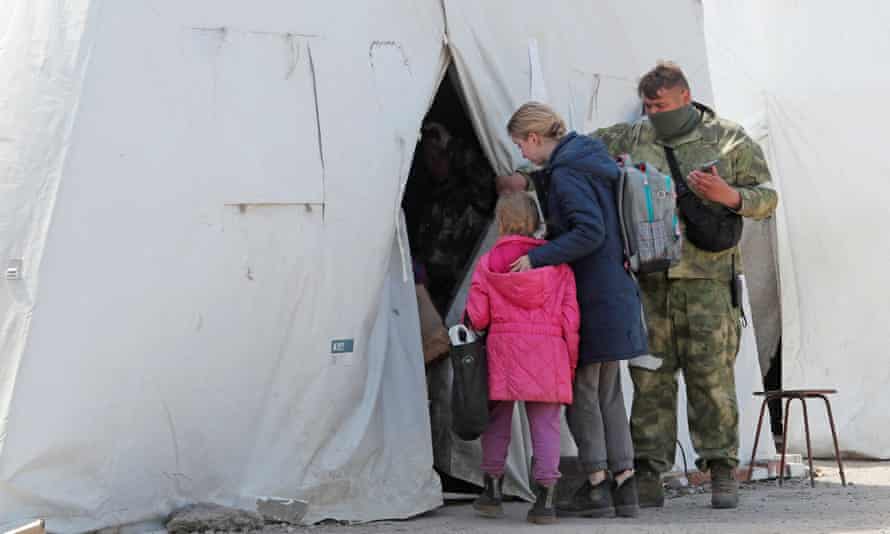
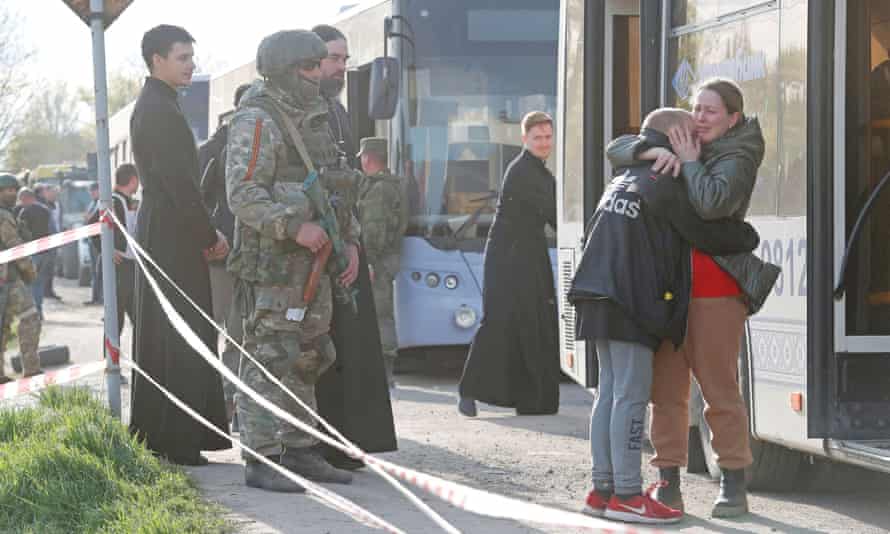
Around 100 civilians were on Sunday evacuated from the Azovstal steelworks in Mariupol, the last holdout of Ukrainian forces in the city. Around 1,000 civilians and 2,000 Ukrainian fighters are thought to be sheltering in bunkers and tunnels underneath the plant, enduring a weeks-long siege with little food or water.
One of the civilians evacuated spoke to Reuters, telling the news agency, “We didn’t see the sun for so long”:
Cowering in the labyrinth of Soviet-era bunkers far beneath the vast Azovstal steel works, Natalia Usmanova felt her heart would stop she was so terrified as Russian bombs rained down on Mariupol, sprinkling her with concrete dust.
Usmanova, 37, spoke to Reuters on Sunday after being evacuated from the plant, a sprawling complex founded under Josef Stalin and designed with a subterranean network of bunkers and tunnels to withstand attack.
“I feared that the bunker would not withstand it – I had terrible fear,” Usmanova said, describing the time sheltering underground.
“When the bunker started to shake, I was hysterical, my husband can vouch for that: I was so worried the bunker would cave in.”
“We didn’t see the sun for so long,” she said, speaking in the village of Bezimenne in an area of Donetsk under the control of Russia-backed separatists around 30 km (20 miles) east of Mariupol.
She recalled the lack of oxygen in the shelters and the fear that had gripped the lives of people hunkered down there.
Usmanova was among dozens of civilians evacuated from the plant in Mariupol, a southern port city that has been besieged by Russian forces for weeks and left a wasteland.
Usmanova said she joked with her husband on the bus ride out, in a convoy agreed by the United Nations and the International Committee of the Red Cross (ICRC), that they would no longer have to go to the lavatory with a torch.
“You just can’t imagine what we have been through – the terror,” Usmanova said. “I lived there, worked there all my life, but what we saw there was just terrible.”

Hello, this is Helen Livingstone taking over the blog from Maanvi Singh to bring you the latest from the war in Ukraine.
First a bit more from Russian foreign minister Sergei Lavrov’s interview with Italy’s Mediaset broadcaster.
He said that Russia was not demanding the “surrender” of Ukrainian president Volodymyr Zelenskiy as a condition for peace.
We do not demand that he surrender. We demand that he give the order to release all civilians and stop the resistance. Our goal does not include regime change in Ukraine. This is an American speciality. They do it all over the world.
We want to ensure the safety of people in the east of Ukraine, so that they are not threatened by either the militarisation or the nazification of this country, and that there are no threats to the security of the Russian Federation from the territory of Ukraine.
He also denied that Russia would attempt to claim victory in Ukraine by 9 May – when Russia marks the end of the second world war with Victory Day – saying that the Russian military would not “artificially adjust their actions to any date, including Victory Day.”
The pace of the operation in Ukraine depends, first of all, on the need to minimise any risks for the civilian population and Russian military personnel.
Asked about recent rumours concerning the health of president Vladimir Putin, he did not answer directly, saying instead:
Ask the foreign leaders who spoke with Russian President Vladimir Putin recently, including UN Secretary-General Antonio Guterres. I think you will understand what is at stake.
Catch up
- Civilians are being evacuated from the Azovstal steel works in Mariupol, where about 1,000 people are thought to be sheltering. The effort is being led by the Red Cross and UN, and coordinated with Ukraine and Russia. Ukrainian president Volodomyr Zelenskiy said that evacuations from Mariupol will continue tomorrow if “all the necessary conditions” are met. “Today, for the first time in all the days of the war, this vital corridor has started working,” he said. “For the first time there were two days of real ceasefire on this territory.”
- US House speaker, Nancy Pelosi, has become the highest-ranking US official to visit Ukraine since the outbreak of war, where she met president Zelenskiy. In a press conference afterwards, Pelosi said that the US would not be bullied. “If they are making threats, you cannot back down,” she said. Pelosi was presented with the order of Princess of Olga medal by Zelenskiy.
- German chancellor Olaf Scholz has pledged to continue supporting Ukraine with money, aid and weapons, saying a pacifist approach to the war is “outdated.”
His remarks to a May Day rally in Dusseldorf were an implicit rebuke to a group of intellectuals, lawyers and creatives who condemned Russia’s war of aggression in an open letter, but urged Scholz not to send heavy weapons to Ukraine.
- Pope Francis described the war in Ukraine as a “macabre regression of humanity” that makes him “suffer and cry”, in a Sunday noon address in St Peter’s Square. “My thoughts go immediately to the Ukrainian city of Mariupol, the city of Mary, barbarously bombarded and destroyed,” he said of the mostly Russian-controlled south-eastern port city, which is named after the Virgin Mary.
- Russia’s latest strikes, including on grain warehouses and residential neighbourhoods, “prove once again that the war against Ukraine is a war of extermination for the Russian army,” Zelenskiy has said in his latest nightly address, asking, “What could be Russia’s strategic success in this war?” The “The ruined lives of people and the burned or stolen property will give nothing to Russia,” he continued.
- Russia’s defence ministry has confirmed an attack on an airfield near Odesa on Saturday. It said its forces had destroyed a runway and hangar at an airfield, which contained weapons supplied by the US and EU.
- The governor of the north eastern city of Kharkiv has urged people not to leave shelters on Sunday due to intense shelling. Posting on Telegram, Oleh Synyehubov said: “In connection with the intense shelling, we urge residents of the northern and eastern districts of Kharkiv, in particular Saltivka, not to leave the shelter during the day without urgency.”
- The European Union could phase out Russian oil imports by the end of the year, under the latest set of sanctions against Vladimir Putin’s war machine being discussed in Brussels.The European Commission president, Ursula von der Leyen, has said for weeks that the EU is working on sanctions targeting Russian oil, but the key question is how and when the commodity is phased out.
- Russia’s online trolling operation is becoming increasingly decentralised and is gaining “incredible traction” on TikTok with disinformation aimed at sowing doubt over events in Ukraine, a US social media researcher has warned. Darren Linvill, professor at Clemson University, South Carolina, who has been studying the Kremlin-linked Internet Research Agency (IRA) troll farm operation since 2017, said it was succeeding in creating more authentic-seeming posts.
- A Russian defence facility near the border with Ukraine was on fire.Vyacheslav Gladkov, the region’s governor, posted on Telegram that there were no details yet about damage or casualties at the building in the southern region of Belgorod. Images on social media showed a large funnel of smoke rising above the ground.
– Jennifer Rankin, Harry Taylor, Maanvi Singh, Rob Booth
In Kherson, the first major city to fall, Russia is replacing Ukrainian currency with Russian rubles.
Per AFP, Kirill Stremousov, a civilian and military administrator of Kherson said that “beginning 1 May, we will move to the ruble zone,” according state news agency RIA Novosti.
It is a tactic to legitimize Russia’s “control of the city and surrounding areas through installing a pro-Russian administration,” according to an intelligence update released by Britain’s Defense Ministry. The move is “indicative of Russian intent to exert strong political and economic influence in Kherson over the long term,” the Defense Ministry said.
Russia’s foreign minister, Sergei Lavrov, said that the county is working to prevent nuclear war, Reuters reports.
In an interview with Italian TV, Lavrov said: “Western media misrepresent Russian threats. Russia has never interrupted efforts to reach agreements that guarantee that a nuclear war never develops”.
Lavrov also doubled down on Russian conspiracy theories and propaganda about Nazism in Ukraine.
This week, Pentagon press secretary John Kirby called Russia’s justification for the war in Ukraine “BS”. “It’s hard to square [Vladimir Putin’s] … BS that this is about Nazism in Ukraine, and it’s about protecting Russians in Ukraine, and it’s about defending Russian national interests, when none of them, none of them were threatened by Ukraine,” Kirby said. “It’s brutality of the coldest and the most depraved sort.”
Eight have died after Russian attacks on Donetsk and Kharkiv, according to the governors of those regions.
AFP reports:
The deaths came as the Russian army refocuses its efforts on eastern Ukraine, notably the Donbas region, which incorporates Donetsk and Lugansk.
Four were killed in shelling in the town of Lyman in Donetsk, the regional governor said.
“On May 1, four civilians were killed in Russian shelling in the Donetsk region, all in Lyman. Eleven other people were injured,” governor Pavlo Kyrylenko said on Telegram.
Another person had died of his injuries in a town near Lyman, he added.
Lyman, a former railway hub known as the “red town” for its redbrick industrial buildings, is expected to be one of the next places to fall to the Russian army after Ukrainian forces withdrew.
Over the past 24 hours, Russian forces appeared to have made notable advances around the town, advancing on their positions by several kilometres, an AFP team in the area said.
Another three people were killed in shelling on residential areas in and around Kharkiv, Ukraine’s second city, the regional governor Oleg Synegubov said on Telegram.
“As a result of these shellings, unfortunately, three people were killed and eight civilians were injured.”
The Ukrainian army has also withdrawn from Kharkiv, its troops now in outlying positions, according to AFP journalists who recently visited the city.
Ukrainian president Volodomyr Zelenskiy said that evacuations from Mariupol will continue tomorrow if “all the necessary conditions” are met. “Today, for the first time in all the days of the war, this vital corridor has started working,” he said. “For the first time there were two days of real ceasefire on this territory.”
In his latest address, he said:
We will continue to do everything to evacuate our people from Azovstal, from Mariupol in general. The organization of such humanitarian corridors is one of the elements of the ongoing negotiation process. It is very complex. But no matter how difficult it was, more than 350,000 people were rescued from the areas of hostilities…
Today, Russian troops continued to strike at the territory of our state. The targets they choose prove once again that the war against Ukraine is a war of extermination for the Russian army. They targeted the warehouses of agricultural enterprises. The grain warehouse was destroyed. The warehouse with fertilizers was also shelled. They continued shelling of residential neighborhoods in the Kharkiv region, Donbas, etc.
They are accumulating forces in the south of the country to try to attack our cities and communities in the Dnipropetrovsk region.
What could be Russia’s strategic success in this war? Honestly, I do not know. The ruined lives of people and the burned or stolen property will give nothing to Russia. It will only increase the toxicity of the Russian state and the number of those in the world who will work to isolate Russia.
‘I collected metal from the missiles in Kharkiv, but couldn’t find anyone to buy it’
Isobel Koshiw and Ed Ram in Kharkiv report:
In Ukraine’s second city, where the barrage of Russian shelling has been among the most relentless endured, hundreds of people stand in line at a post office, waiting to be given chicken and potatoes. As elsewhere in the country, the mundane institutions of civil society of Kharkiv have had to be hastily repurposed for the goal of keeping its population alive, and about 30 such locations across the city have been turned into food aid distribution points.
The postal workers at this branch of Nova Poshta, who are being paid by their employer to hand out food instead of post, say that an average of 3,000 people come to their repurposed branch every day, seven days a week. They manage the queues using the post office’s ticket system.
“There’s no work. The No 1 thing at the moment is humanitarian aid,” says Ihor Shapovalov, a construction worker who lost his job on 24 February and has just received a quarter of a chicken. “We just want to thank the guys for everything they’re doing.”
Kharkiv has been the worst-hit city still under Ukrainian government control. Since the war began two months ago, civilians have died and been injured almost every day as a result of incoming Russian shelling. On Saturday, one person died and five were injured as a result of mortar fire, according to the regional governor.
The city is starting to see signs of life, but its economy is in tatters. The vast majority of shops and businesses are still closed.
Another man waiting in the queue at the repurposed post office is 30-year-old Zhenia Myrhorod. He says he had tried to get work unloading humanitarian aid at a warehouse, but there was not enough work to go around.
“I even collected metal from the missiles but couldn’t find anyone to buy it,” says Myrhorod. “I’m 30 years old. I’ve got legs and arms, but nobody wants them.”
Read more:
Reference-www.theguardian.com